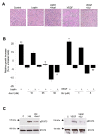Glioblastoma-derived leptin induces tube formation and growth of endothelial cells: comparison with VEGF effects
- PMID: 21771332
- PMCID: PMC3146945
- DOI: 10.1186/1471-2407-11-303
Glioblastoma-derived leptin induces tube formation and growth of endothelial cells: comparison with VEGF effects
Abstract
Background: Leptin is a pleiotropic hormone whose mitogenic and angiogenic activity has been implicated in the development and progression of several malignancies, including brain tumors. In human brain cancer, especially in glioblastoma multiforme (GBM), leptin and its receptor (ObR) are overexpressed relative to normal tissue. Until present, the potential of intratumoral leptin to exert proangiogenic effects on endothelial cells has not been addressed. Using in vitro models, we investigated if GBM can express leptin, if leptin can affect angiogenic and mitogenic potential of endothelial cells, and if its action can be inhibited with specific ObR antagonists. Leptin effects were compared with that induced by the best-characterized angiogenic regulator, VEGF.
Results: We found that GBM cell lines LN18 and LN229 express leptin mRNA and LN18 cells secrete detectable amounts of leptin protein. Both lines also expressed and secreted VEGF. The conditioned medium (CM) of LN18 and LN 229 cultures as well as 200 ng/mL pure leptin or 50 ng/mL pure VEGF stimulated proliferation of human umbilical vein endothelial cells (HUVEC) at 24 h of treatment. Mitogenic effects of CM were ~2-fold greater than that of pure growth factors. Furthermore, CM treatment of HUVEC for 24 h increased tube formation by ~5.5-fold, while leptin increased tube formation by ~ 80% and VEGF by ~60% at 8 h. The mitogenic and angiogenic effects of both CM were blocked by Aca 1, a peptide ObR antagonist, and by SU1498, which inhibits the VEGF receptor. The best anti-angiogenic and cytostatic effects of Aca1 were obtained with 10 nM and 25 nM, respectively, while for SU1498, the best growth and angiogenic inhibition was observed at 5 μM. The combination of 5 μM SU1498 and Aca1 at 25 nM (growth inhibition) or at 10 nM (reduction of tube formation) produced superior effects compared with single agent treatments.
Conclusions: Our data provide the first evidence that LN18 and LN 229 human GBM cells express leptin mRNA and might produce biologically active leptin, which can stimulate tube formation and enhance proliferation of endothelial cells. Furthermore, we demonstrate for the first time that a peptide ObR antagonist inhibits proangiogenic and growth effects of leptin on endothelial cells, and that the pharmacological potential of this compound might be combined with drugs targeting the VEGF pathway.
Figures




Similar articles
-
Exploring leptin antagonism in ophthalmic cell models.PLoS One. 2013 Oct 3;8(10):e76437. doi: 10.1371/journal.pone.0076437. eCollection 2013. PLoS One. 2013. PMID: 24098500 Free PMC article.
-
Asiatic acid inhibits pro-angiogenic effects of VEGF and human gliomas in endothelial cell culture models.PLoS One. 2011;6(8):e22745. doi: 10.1371/journal.pone.0022745. Epub 2011 Aug 3. PLoS One. 2011. PMID: 21826202 Free PMC article.
-
Anti-angiogenic actions of pyrrolidine dithiocarbamate, a nuclear factor kappa B inhibitor.Angiogenesis. 2009;12(4):365-79. doi: 10.1007/s10456-009-9158-0. Epub 2009 Oct 14. Angiogenesis. 2009. PMID: 19882112
-
[The vascular endothelial growth factor (VEGF): a model of gene regulation and a marker of tumour aggressiveness. An obvious therapeutic target?].J Soc Biol. 2009;203(2):181-92. doi: 10.1051/jbio/2009022. Epub 2009 Jun 16. J Soc Biol. 2009. PMID: 19527632 Review. French.
-
Anti-VEGF therapies for malignant glioma: treatment effects and escape mechanisms.Expert Opin Ther Targets. 2009 Apr;13(4):455-68. doi: 10.1517/14728220902806444. Expert Opin Ther Targets. 2009. PMID: 19335067 Review.
Cited by
-
Leptin: A Heavyweight Player in Obesity-Related Cancers.Biomolecules. 2023 Jul 6;13(7):1084. doi: 10.3390/biom13071084. Biomolecules. 2023. PMID: 37509120 Free PMC article. Review.
-
Overexpression of leptin receptor in human glioblastoma: Correlation with vasculogenic mimicry and poor prognosis.Oncotarget. 2017 Apr 21;8(35):58163-58171. doi: 10.18632/oncotarget.17344. eCollection 2017 Aug 29. Oncotarget. 2017. PMID: 28938545 Free PMC article.
-
Intracellular adenosine regulates epigenetic programming in endothelial cells to promote angiogenesis.EMBO Mol Med. 2017 Sep;9(9):1263-1278. doi: 10.15252/emmm.201607066. EMBO Mol Med. 2017. PMID: 28751580 Free PMC article.
-
Leptin and Cancer: Updated Functional Roles in Carcinogenesis, Therapeutic Niches, and Developments.Int J Mol Sci. 2021 Mar 11;22(6):2870. doi: 10.3390/ijms22062870. Int J Mol Sci. 2021. PMID: 33799880 Free PMC article. Review.
-
Exploring leptin antagonism in ophthalmic cell models.PLoS One. 2013 Oct 3;8(10):e76437. doi: 10.1371/journal.pone.0076437. eCollection 2013. PLoS One. 2013. PMID: 24098500 Free PMC article.
References
-
- Friedman JM, Halaas JL. Leptin and the regulation of body weight in mammals. Nature. 1998;395(6704):763–770. - PubMed
-
- Zhang F, Chen Y, Heiman M, Dimarchi R. Leptin: structure, function and biology. Vitam Horm. 2005;71:345–372. - PubMed
-
- Rahmouni K, Haynes WG. Endothelial effects of leptin: implications in health and diseases. Curr Diab Rep. 2005;5(4):260–266. - PubMed
-
- Vona-Davis L, Rose DP. Angiogenesis, adipokines and breast cancer. Cytokine Growth Factor Rev. 2009;20(3):193–201. - PubMed
Publication types
MeSH terms
Substances
LinkOut - more resources
Full Text Sources
Molecular Biology Databases
Miscellaneous

